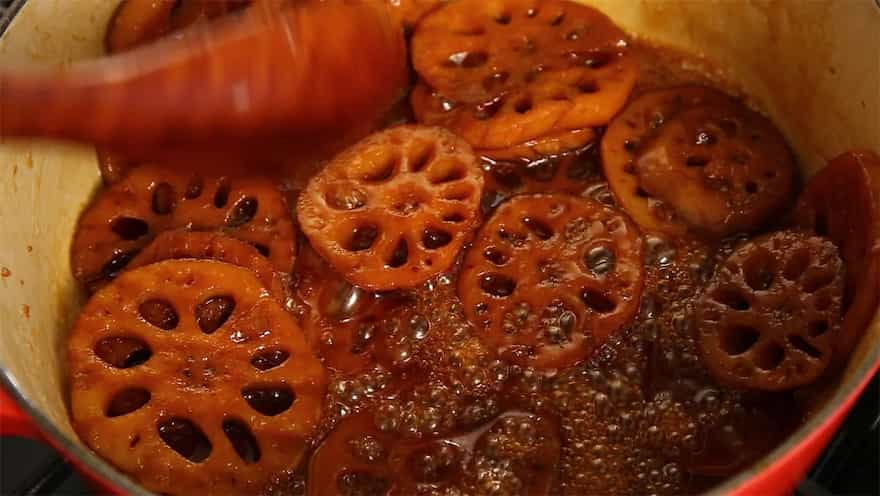Pickles have been a part of Indian cuisine since the dawn of time, and they go well beyond the western concept of vinegar-preserving vegetables and fruits. Mangoes, Lemons, and Chilies are unquestionably the most popular components in pickles found in every state of India, and they spice up our palate and taste buds with a fiery and tangy punch of tastes. Indian pickles, on the other hand, go beyond the ordinary mixtures of spices and flavours that we are used to. We've hand-selected some unique pickles from all four corners of the country to underline our passion for pickles and they're sure to make your mouth water and wow your senses, at least visually!
Lotus Stem Pickle
Kashmiris and Sindhis disagree with those who believe a lotus is nothing more than a flower. They'll make it clear that the flower's stem is a savoury treat that's commonly utilised in fritters and pickles. This spicy relish is produced by combining nigella seeds, chilli powder, fennel seeds, coriander seeds, turmeric powder, red chilies, peppercorns, salt, and oil with slices of the matured stem of the plant.

Lingri ka Achaar
The fiddlehead fern, also known as lingri in Himachal Pradesh, is used in the state's culinary traditions as a gently sweet pickle. The pickles are made from the tiny, soft, tight curls new shoots of ferns, which are not grown but simply sprout in the region like any other fern species. Surprisingly, this vegetable is not grown and can only be found in temperate locations during the growing season. So, if you're planning a trip to Himachal this winter, pack your backpack with jars and jars of this delectable greenish pickle and bring it home to store and consume.
Gor Keri
Gor keri is a delicious mango pickle made with raw mangos, sugar, jaggery, and spices. The mango slices are traditionally coated in jaggery and left in the sun for two weeks until the sugary goodness melts into a stringy consistency. Gor keri pickle, a mango-jaggery combo, that tastes excellent after a few months of maturation.
 Image credit: Pexels
Image credit: Pexels
Mesu, a Sikkimese pickle prepared with fermented bamboo shoots and boasting a great sour-acidic tang, is an underdog among Indian pickles. Mesu is drawn straight from the Limbu dialect of Sikkim, where 'me' refers to a young bamboo shoot and 'su' refers to a sour taste.
Bhoot Jolokia Achaar
Assam's Bhoot Jolokia, also known as the Ghost or King Chilli, is so spicy that locals say after eating one, they wish they were dead! Its pickle, on the other hand, can be enjoyed without fear of death. The spicy red chilli pickle is frequently laced with bamboo shoots, and despite its fiery flavour, it is well-known worldwide.
Chana Methi Achaar
This distinctive pickle, which is made of chickpeas and dry fenugreek seeds perked up with a huge selection of spices and preserved with mustard oil, is somewhat lesser recognised across the country. Variations of the same can be found, with mango being the most prevalent addition.
Banana Flower Pickle
This pickle hails from Assam and is made out of banana flowers, which are high in iron, calcium, and a variety of other nutrients. While the superfood is consumed in other regions of the country, banana flower pickle is unquestionably one of Assam's most unique concoctions.
Tindora Achaar
Many people dislike this modest vegetable, but if you know what you're doing, you won't be able to resist the delicious taste of kundru or tindora (Ivy Gourd) pickles. Set aside any doubts and give this delectable pickle a try! It's one of Gujarat's most famous pickles.
Kair ka Achaar
This pickle is peculiar to Rajasthan and is abundant throughout the winters. It is made from Kair (dried and utilised Rajasthan berries). Kair ke achaar is a tangy, sour relish that goes well with any Indian dish, breads or rice.
Gandal ka Achaar
Gandal ka Achaar is a traditional Punjabi dish created by pickling the long stalks of mustard greens (gandal) immediately before the seed harvesting for mustard oil in December. Apart from the delicious taste, the mustard in the pickle acts as a warming agent, keeping the family warm during the cold winter months.


